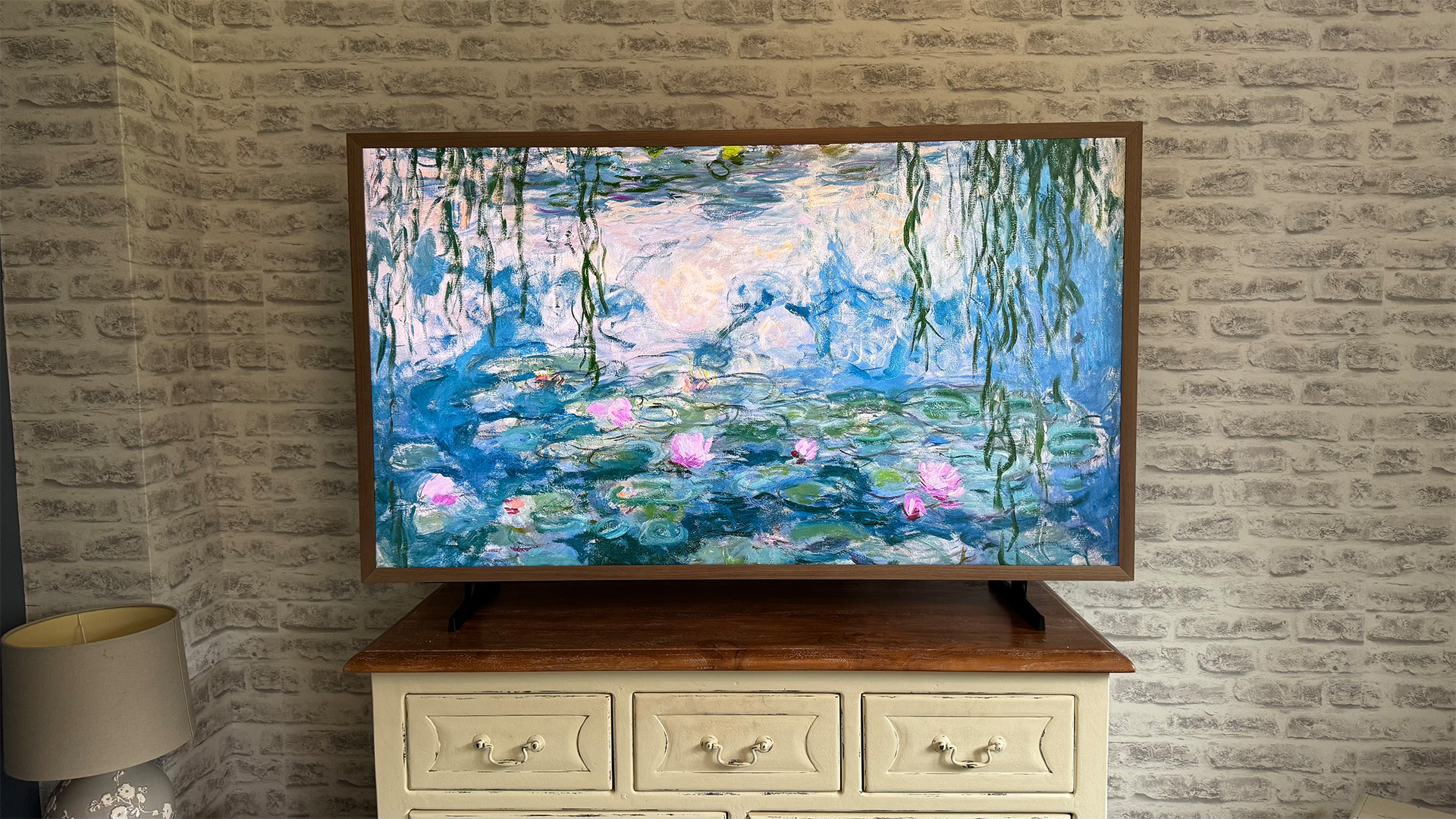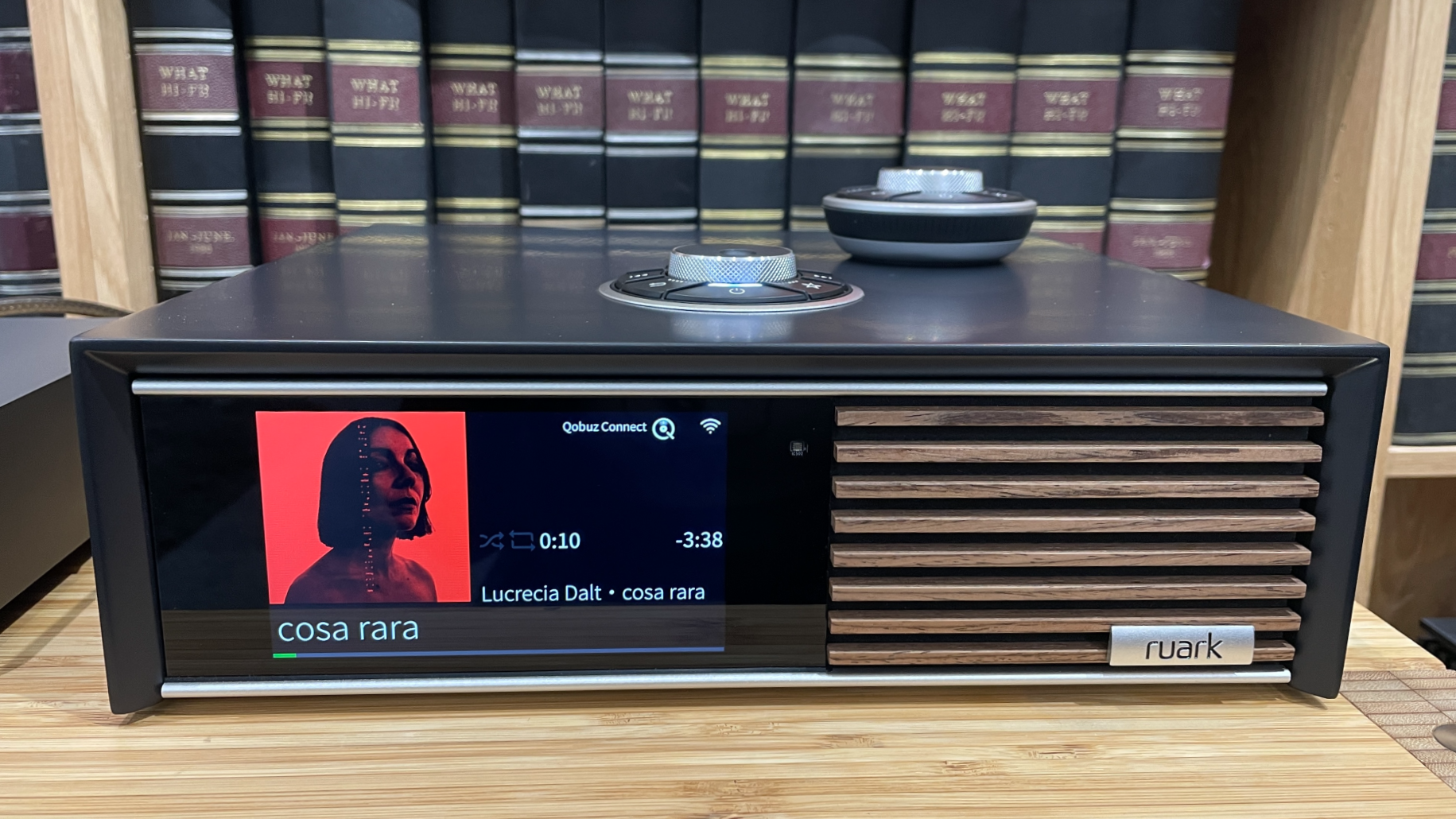What Hi-Fi? Verdict
The Hisense Canvas TV looks a million dollars but ends up feeling expensive for the level of performance it offers
Pros
- +
Swappable frame and matte screen work well
- +
Impressive smart TV support, including Freely
- +
Good set of gaming features
Cons
- -
Poor contrast
- -
Expensive for its performance level
- -
Low-quality sound
Why you can trust What Hi-Fi?
Televisions designed to blend in with your decor are hardly a new concept. Right back in the very earliest days of TV technology, sets were designed to look like pieces of furniture. The arrival of flat panel screens, though, has seen the idea of TVs that don’t look like TVs reach elegant new heights.
Now a TV can be made to look pretty much exactly like a painting when you’re not using it – a concept popularised by Samsung’s The Frame TVs, and now being enthusiastically embraced by Hisense with its new Canvas TV, tested here in 55-inch form.
Price
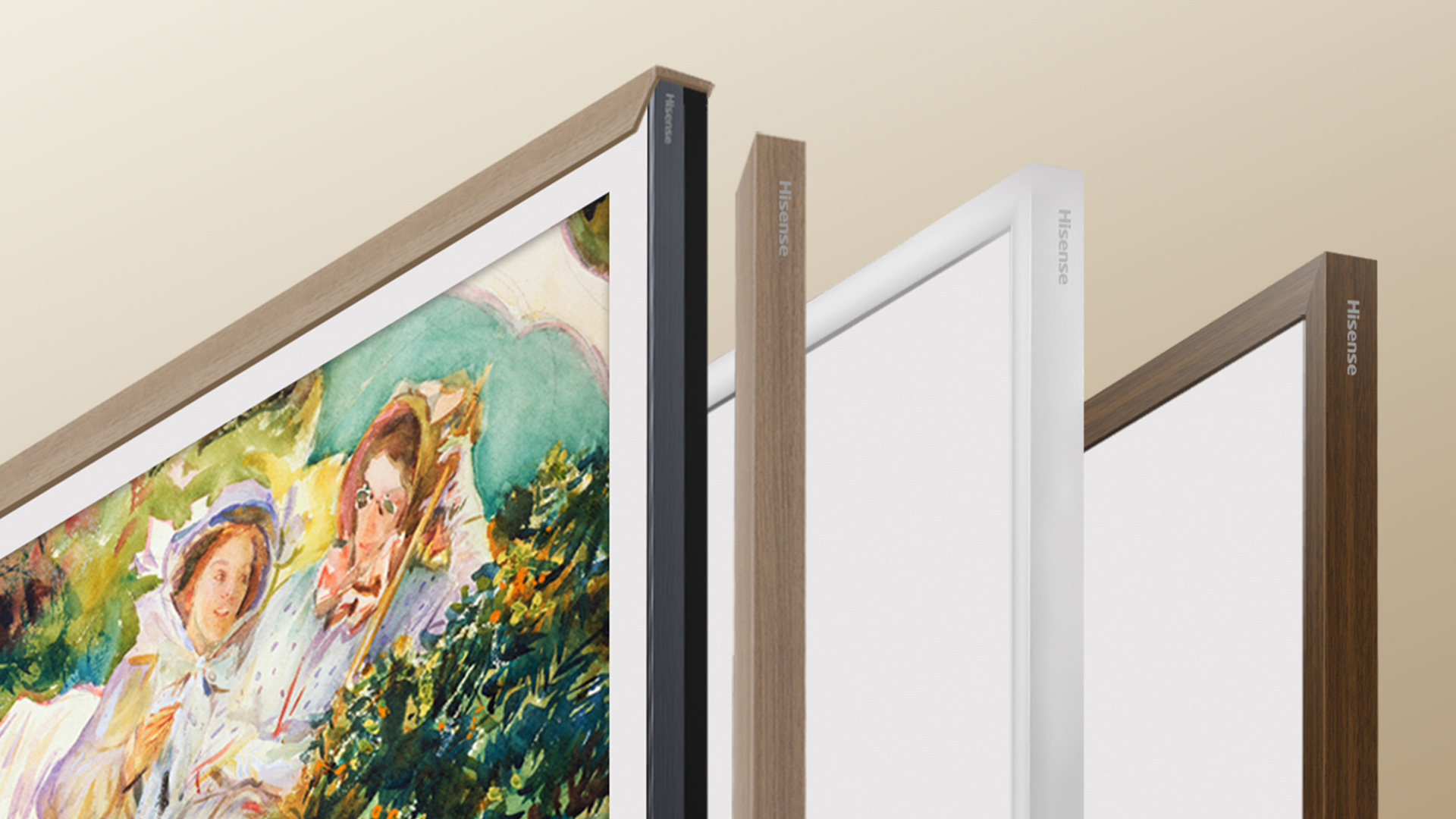
How good value the Hisense Canvas TV is depends on how and where you look at it. Considered in isolation, £1099 / $1100 / AU$1799 doesn’t look too bad for a TV that provides a 55-inch screen with interchangeable frame designs, a painting-like matte screen, lots of digital art options for display on the screen when you’re not watching it, extensive HDR support, and a native 4K resolution.
But, thanks to many months of discounting, Samsung’s The Frame is now available for similar money.
And if you’re willing to forego the whole TV-as-a-painting schtick in favour of a ‘regular’ TV that still looks pretty decent when hung on a wall, the Sony 55-inch Bravia 7 is an outstanding performer that costs only a little more than the Hisense.
Design
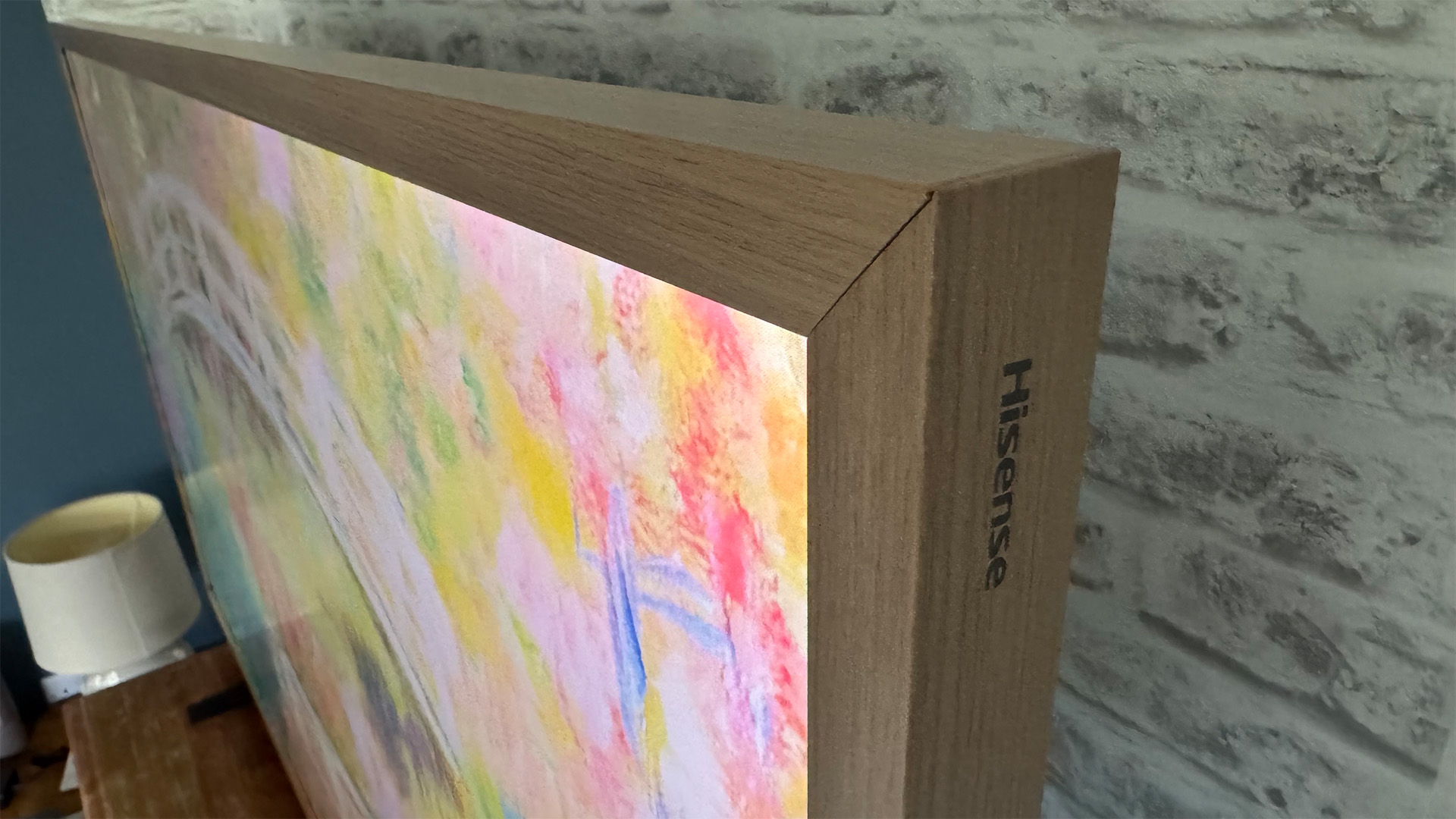
Its design is, of course, a more key component of the Canvas TV’s appeal than it would be with a regular TV – so it’s just as well that it lives up to its ‘Canvas’ billing extremely well.
The ‘core’ TV is actually a fairly regular-looking set, albeit one with an unusually slim, metallic black bezel wrapped around the screen. It’s soon transformed into something much more artistic and gallery-esque, though, once you’ve slotted the magnetic mock teak metal covers over the TV’s original bare edges. This new frame is wide and chamfered, and its wood styling actually looks pretty convincing. At least from a distance.
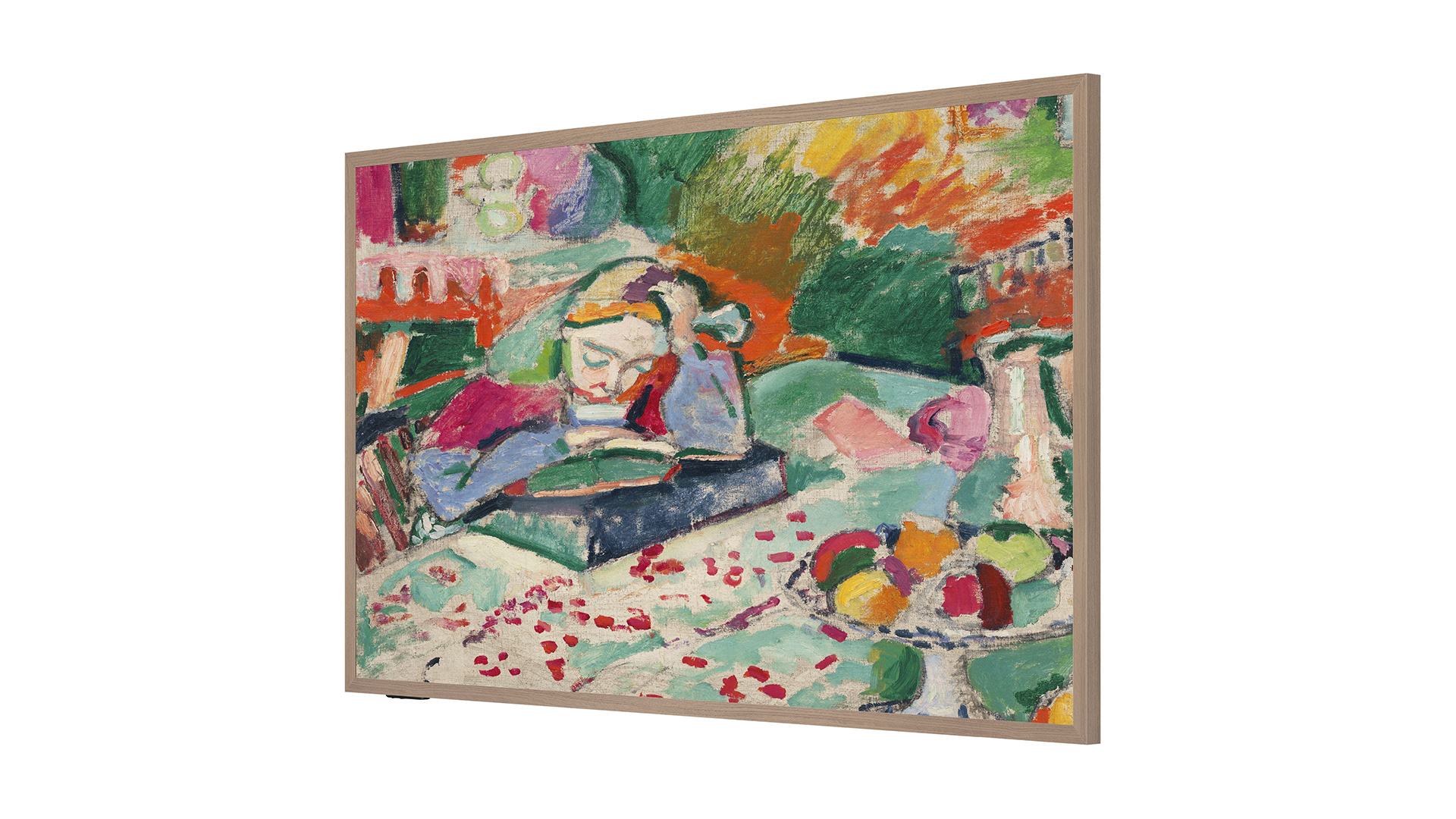
Screen size 55 inches (also available in 65 inches)
Type QLED
Backlight Edge LED
Resolution 4K
HDR formats HLG, HDR10, HDR10+,Dolby Vision
Operating system VIDAA
HDMI inputs x 4 (2 x 48Gbps HDMI 2.1)
Gaming features 4K/144Hz, 4K/120Hz, VRR, ALLM, Dolby Vision game mode
Input lag 16ms (60Hz)
ARC/eARC eARC
Optical output? Yes
Dimensions (hwd, without stand) 74 x 126 x 3.9cm
You are left with visible seams in each corner – but that would usually be the case with an actual wooden painting frame too, and the seams aren’t too noticeable so long as you’re careful to slot the edges really snugly up against each other.
If you’re not particularly enamoured of the teak frame the TV is shipped with as standard, you can also buy walnut and white ‘StyleSwap’ alternatives, as well as a range of premium metal bezel options.
The matte screen adds to the painting impression almost uncannily well, too, doing at least as effective a job as the Samsung Frame’s similarly light- and reflection-absorbing screen of making the TV feel like its pictures are being ‘painted’ in real time on canvas rather than just being shown on a traditional LCD TV display.
The Canvas TV seals its ‘hang it in the Louvre’ look with an included UltraSlim wall mount that makes it possible to hang the TV flush with your wall. You can fasten a couple of feet to it instead if you want to put it on a bit of furniture, but clearly its design is most effective if it’s hung up.
The Canvas ships with a large but attractive and glossily finished remote control, complete with a number of direct app access buttons, a nice metallic navigation ‘ring’, and a solar panel built into the bottom to save you from ever having to change its batteries.
Features
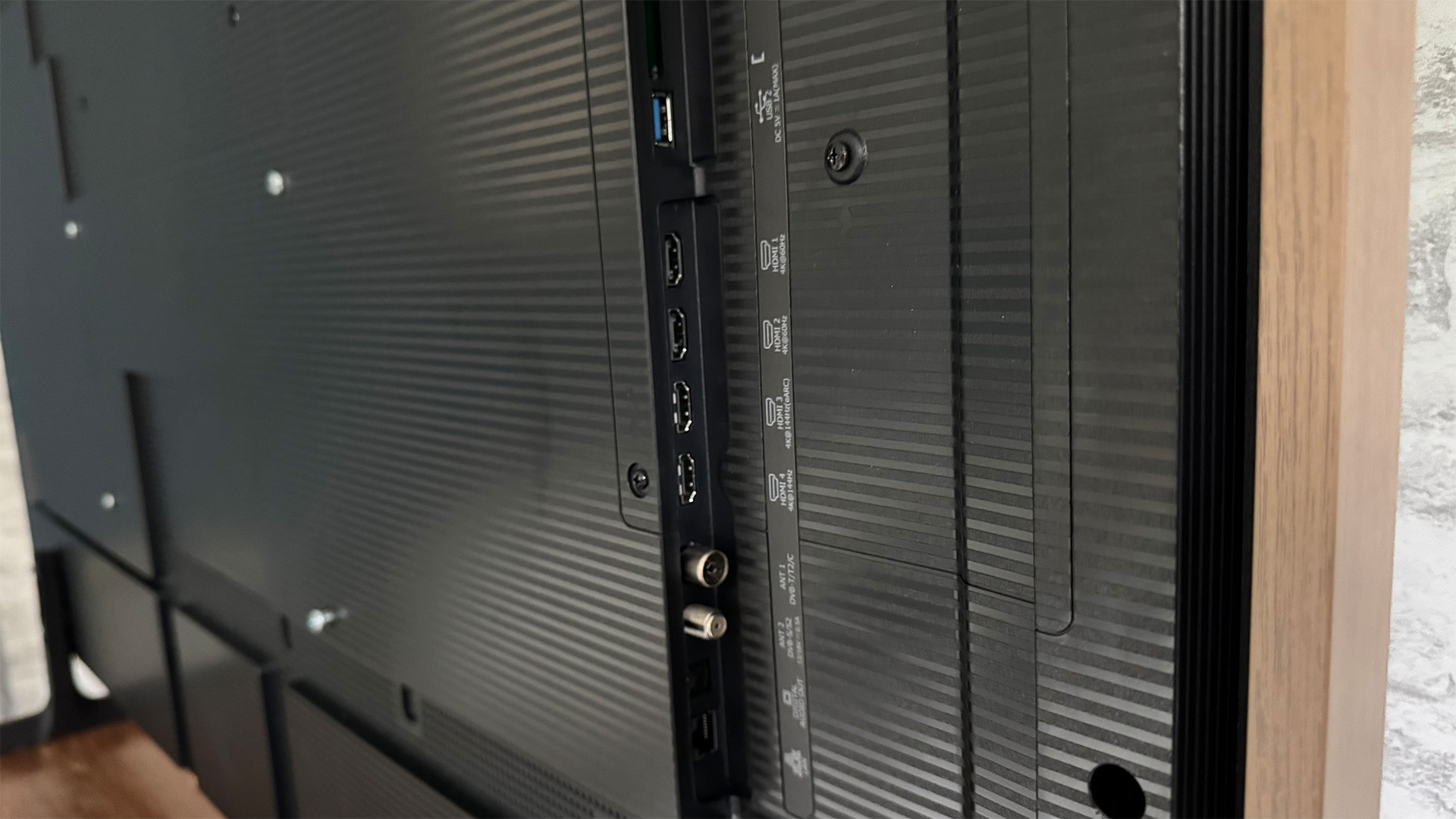
The fact that it’s called the Canvas clearly establishes right away that this Hisense TV’s design is its ‘killer app’ – and we’ve covered most aspects of that design in the previous section. There are still a few other tricks up its designer sleeve that deserve a mention, though, including a couple more associated with its ambition to be as much a work of art as a TV.
The Canvas TV’s Art Mode, for instance, lets you choose what you want the screen to show when it’s in its ‘painting’ rather than TV mode. Options available include your own digital photos, 300 free digital works of art and, if you set up an account with Hisense’s VIDAA smart system, more than 1000 digitised works of art via the VIDAA Art App.
The Art Mode also features a motion detector element that can constantly scan the room for movement up to a distance of 4 metres and turn the TV properly into standby if it thinks nobody is in the room to witness its painterly charms.
While the Canvas TV’s matte finish feels pretty cutting edge, in other ways its screen seems a bit basic for a TV costing as much as it does.
The panel is apparently a VA-style one rather than a low-contrast IPS one, at least (which isn’t always a given with Hisense TVs) – but it’s lit by LEDs arranged around its edges rather than directly behind the screen. It doesn’t benefit from any local dimming technology, either.
The lack of light control associated with this sort of LED lighting configuration doesn’t bode well for an HDR-capable LCD TV.
More promising is the Canvas TV’s Quantum Dot colour system. This should help the TV deliver wider colour gamuts and greater colour stability at high brightness levels – though the apparently relatively low-spec of the screen’s LED light controls means we can’t help but recall how some budget TVs we’ve seen in recent years have struggled to combine QD colour systems with good contrast and black levels.
The VIDAA Smart system the Canvas TV supports has become one of the better TV smart systems around, at least when it comes to ease of use.
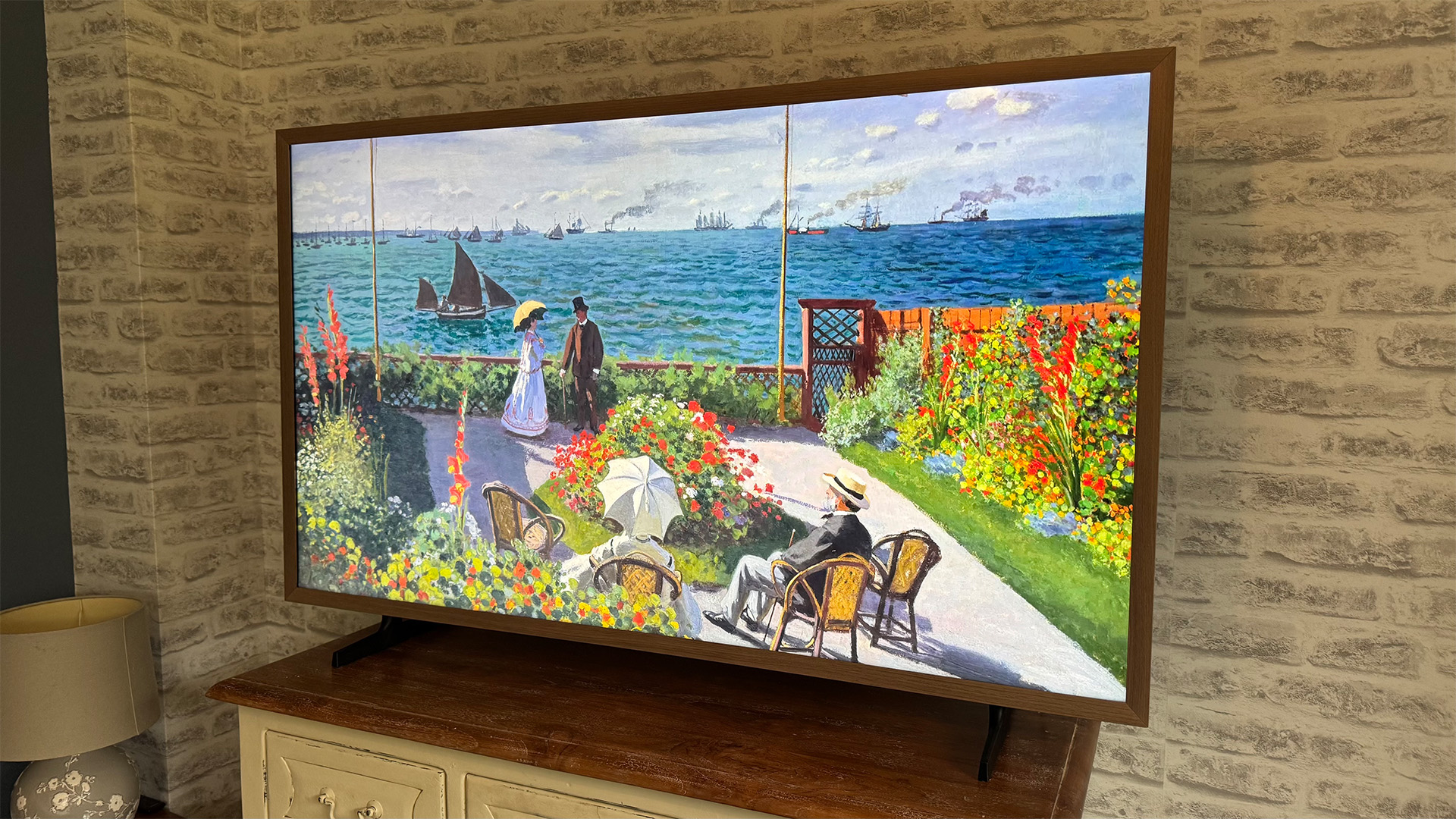
Its menus aren’t the most glamorous, but they get the job done without fuss or confusion – and these days they also carry all the main streaming services: Netflix, Prime Video, Apple TV+, Disney+, YouTube, BBC iPlayer, ITV X, Channel 4, My5, Now TV, Paramount+ and more. UK buyers even get the new Freely platform, which lets you live stream many of the terrestrial TV channels found within the Freeview broadcast system.
The Canvas TV is similarly comprehensive, impressively, when it comes to support for HDR formats. All four that matter are covered: HDR10, HLG, Dolby Vision and HDR10+. In fact, a built-in RGB sensor enables the Canvas TV to support the HDR10+ Adaptive and Dolby Vision IQ formats, which adjust images to suit the ambient light conditions in your room.
The Canvas TV’s connectivity is pretty strong for a TV ostensibly built first and foremost on its design. In particular, two of its four HDMI ports are capable of not just handling 4K/120Hz gaming graphics from the latest consoles and premium PCs, but also 144Hz refresh rates.
Gamers also benefit from VRR support, including the AMD FreeSync Premium system, as well as the ability to have the screen automatically switch into its low-latency Game mode when a game source is detected.
This Game mode gets the time it takes to render 60Hz game images received at the TV’s HDMI ports down to a pretty respectable 16ms or so, and the TV can also automatically switch to a Game-based menu system when it detects that it's being used as a gaming display. This is all unexpectedly positive stuff for gamers, given some of the screen’s apparent video limitations.
The Canvas TV’s connectivity also extends to both wi-fi and Bluetooth wireless content sharing, of course, and there are two USB sockets (one 2.0, one 3.0), and an optical digital audio output. You can use the USBs to provide the Canvas TV with digital photos for its Art Mode if you wish, rather than having to depend on Bluetooth.
Picture
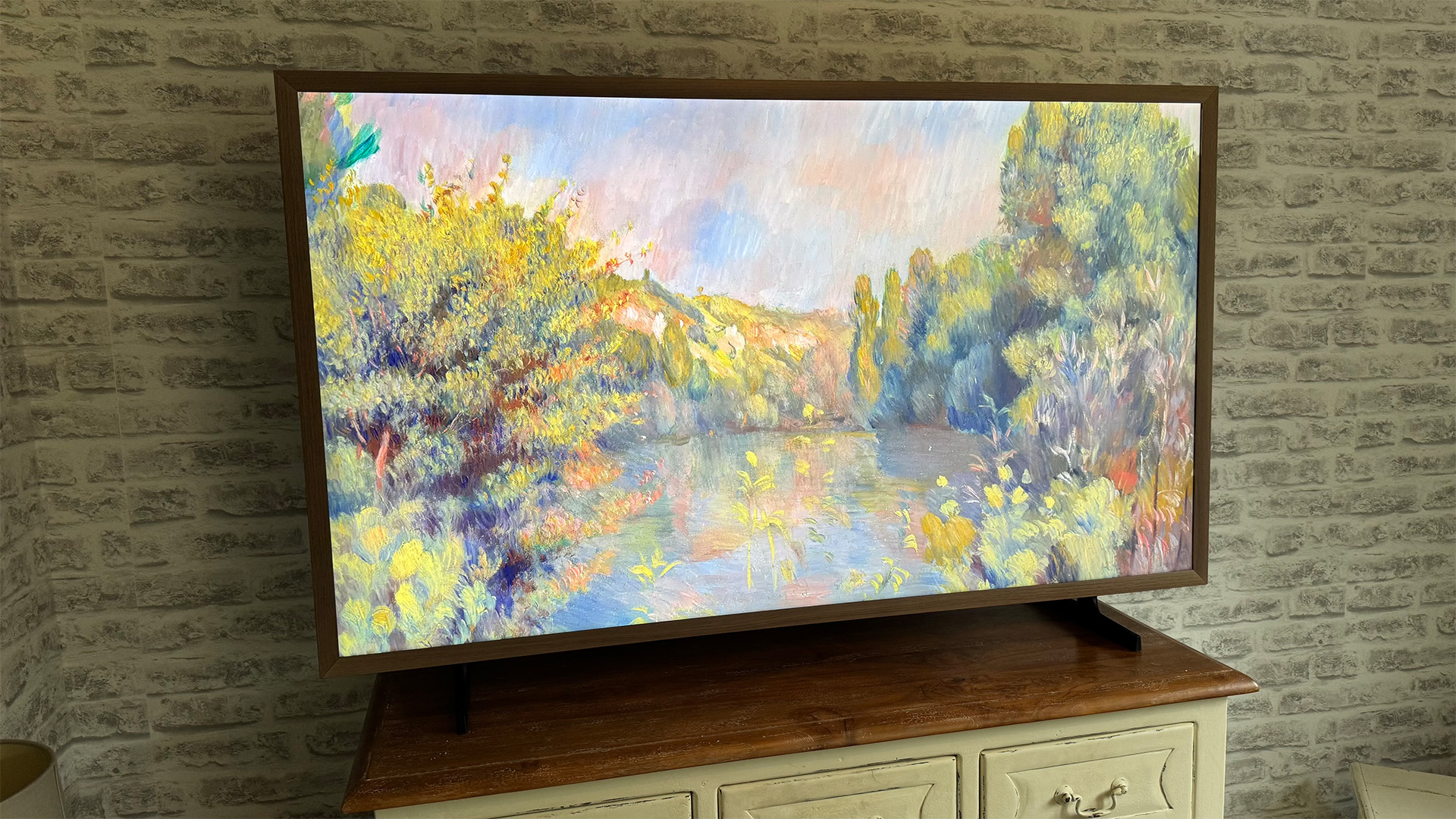
Unfortunately, the Canvas TV’s picture quality is a real disappointment. In particular, as feared, the edge LED backlighting and lack of local dimming prevent it from delivering anything like the sort of black depth and contrast we would expect to see.
A depressing pall of grey hangs over any dark images, making them look unconvincing and flat. Worse, the greyness isn’t even consistent across the image, with some parts of the screen exhibiting more aggressive clouding than others.
This means that even if you learn to somehow mentally tune out the greyness in dark scenes and dark picture areas, you’re still left with an aggressive backlight inconsistency that no amount of mental gymnastics can filter away.
We’ve seen TVs costing less than half as much as the Hisense handle dark scenes more convincingly and effectively.
The light-rejecting Canvas screen does, at least, prevent dark scenes from having to appear behind the sort of onscreen reflections that most TVs suffer with when watched in daylight. But who cares when those dark scenes look so grey and misty anyway?
The Canvas’s low contrast greyness does not at least cause the TV to ‘wash out’ subtle details in what should be dark picture areas and scenes. In fact, the lack of any sort of sophisticated light control actually finds the Canvas bringing out way too much picture information in dark areas, revealing details and noise that the content creators never intended to be visible.
While this is a fairly common issue with HDR-capable TVs stuck with inadequate light controls, we don’t think we’ve seen quite such a grim demonstration of it before. Especially as the problem is exaggerated on the Canvas TV by a pronounced green tinge that creeps into pretty much any dark scene.
The Canvas TV’s difficulties with rendering anything approaching black knocks on into other areas of its pictures, too.
The extent of its HDR performance, for instance, is inevitably limited by its inability to deliver the dark end of HDR’s extended light range. An HDR-limiting situation made worse by the fact that while the screen does manage to deliver small bright highlights with a bit more local intensity than we’d expected to see from an edge LED lighting system, overall the screen can’t get nearly as bright as we would expect from a TV at this level in 2025.
For most of the time, the intensity the Canvas TV imbues bright HDR scenes with is just a fraction of that achieved by, for instance, Sony’s Bravia 7.
Hisense itself states that the screen is only rated to achieve a peak brightness of around 400 nits, which is a pretty puny figure by today’s mid-range TV standards.
As we’ve seen with some budget TVs, the Canvas TV’s backlight shortcomings feed into its Quantum Dot colours, too. There’s a slightly washed-out, faded feel to its palette, especially in dark scenes, which can also mean that some subtle colour shifts and blends go AWOL, leaving washes of colour sometimes looking a bit plasticky and smooth.
Not being able to render subtle colour tone changes as accurately as hoped knocks on into the screen’s sharpness, too, denying it the sort of ‘4K effect’ we’d have liked to see. That’s not the only reason that even native 4K images don’t look as pristine on the Canvas TV as we’d expect them to, though; there’s also a slightly blurry look to motion that Hisense’s motion processing system can’t seem to do much about.
Despite its many limitations, the Canvas TV can look at least enjoyable with relatively undemanding sources, such as regular daytime SDR TV shows. Its daytime viewing credentials are further boosted, too, by the ambient light-rejecting qualities of its screen.
It also works rather well in Art Mode, delivering its digital artwork or photograph ‘screensavers’ with a crispness you don’t get with moving images and, provided you choose a fairly bright, colourful photograph or painting, disguising the contrast problems exposed during any sort of serious HDR video viewing.
In the end, though, while we would always cut any TV built to meet a very specific design need a degree of picture quality slack, in the Hisense Canvas’s case, the level of picture compromise you’re expected to swallow is just way too high for comfort.
Sound
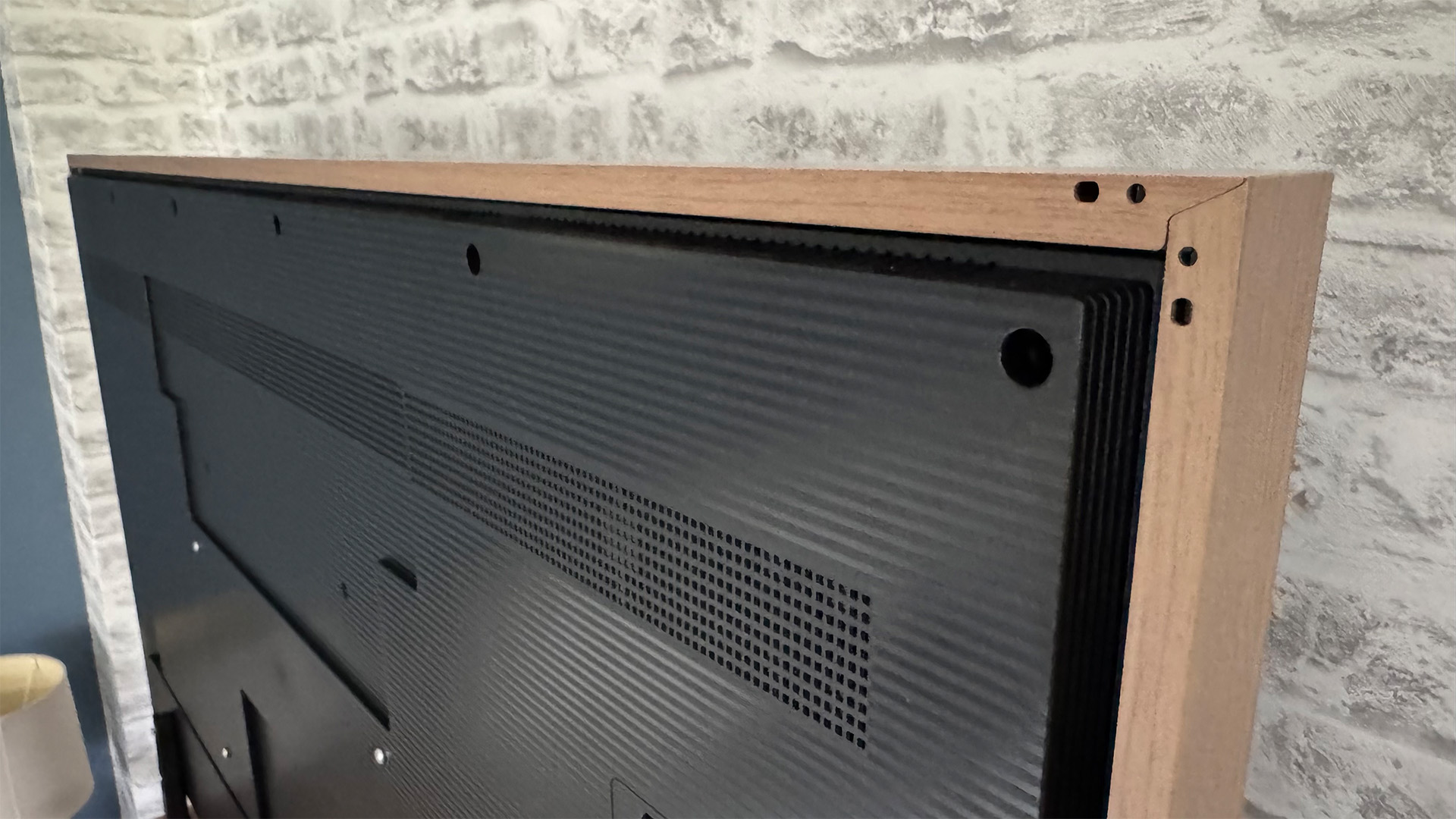
Despite its fairly slender profile and clip-on frame, the Canvas TV’s 2.0.2-channel speaker configuration (comprising two 10W main drivers and two 8W up-firers to support its Dolby Atmos and DTS Virtual X capabilities) raises hopes that it will do better with sound than it does with video. Unfortunately, though, this doesn’t pan out.
Starting charitably with the good things about its sound, it can get seriously loud. At not much higher than half of its maximum volume setting, it belts out more of a racket than most ears will be comfortable with.
This fairly extreme power handling means, too, that it has enough headroom in its speakers, even when running loud, to shift up and down a few gears when delivering action scenes. There’s none of that sense you get with many TVs of the sound flattening off or even dropping away as loud, dense movie moments reach a climax.
The Canvas’s raw power helps it radiate its sound with some force out into your room, too, rather than leaving the action sounding trapped in the TV.
The problem is that there’s precious little refinement, control or basic quality to go with the Canvas TV’s ability to make lots of noise. So, for instance, there’s a really harsh quality to loud movie moments that isn’t easy on the ear. Shrill sounds cause the speakers to emit a distracting accompanying buzz, too, and what should be mild ambient effects often become far too exaggerated in the mix, making complex film soundtracks appear confusing and brash.
It doesn’t help that there isn’t enough bass presence to properly counterpoint the harsh trebles, either. Even if you turn the TV’s Bass Enhance feature on.
Some of the harsher aspects and imbalances of the Canvas TV’s sound diminish in impact if you keep the set’s volume fairly low. But this isn’t a very ‘movie night friendly’ compromise, and in truth, it still doesn’t stop the Canvas TV from sounding distractingly coarse.
Verdict
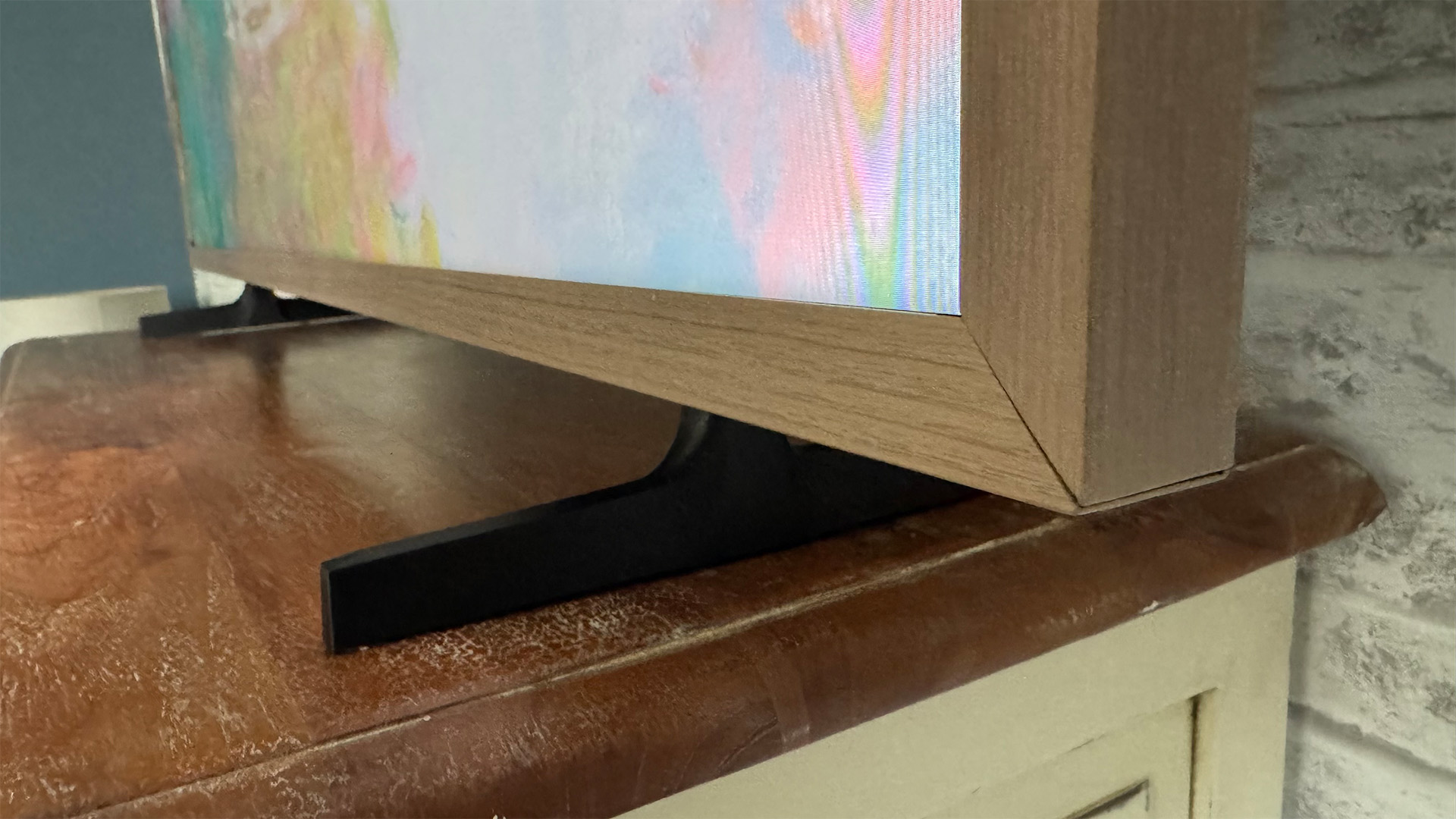
While we appreciate what Hisense has done with the Canvas TV’s design, especially the remarkable way its screen rejects ambient light reflections, it isn’t nearly good enough on either the picture or sound quality fronts for the compromise to be acceptable.
SCORES
- Picture 2
- Sound 2
- Features 4
MORE:
Read our review of the Sony Bravia 7 55-inch
Also consider the TCL 55C805K
Read our Amazon Fire TV Omni Mini LED review
Best TVs: flagship OLEDs and affordable flatscreens tried and tested
John Archer has written about TVs, projectors and other AV gear for, terrifyingly, nearly 30 years. Having started out with a brief but fun stint at Amiga Action magazine and then another brief, rather less fun stint working for Hansard in the Houses Of Parliament, he finally got into writing about AV kit properly at What Video and Home Cinema Choice magazines, eventually becoming Deputy Editor at the latter, before going freelance. As a freelancer John has covered AV technology for just about every tech magazine and website going, including Forbes, T3, TechRadar and Trusted Reviews. When not testing AV gear, John can usually be found gaming far more than is healthy for a middle-aged man, or at the gym trying and failing to make up for the amount of time he spends staring at screens.
You must confirm your public display name before commenting
Please logout and then login again, you will then be prompted to enter your display name.
